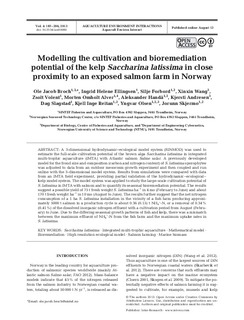| dc.contributor.author | Broch, Ole Jacob | |
| dc.contributor.author | Ellingsen, Ingrid H. | |
| dc.contributor.author | Forbord, Silje | |
| dc.contributor.author | Wang, Xinxin | |
| dc.contributor.author | Volent, Zsolt | |
| dc.contributor.author | Alver, Morten | |
| dc.contributor.author | Handå, Aleksander | |
| dc.contributor.author | Andresen, Kjersti | |
| dc.contributor.author | Slagstad, Dag | |
| dc.contributor.author | Reitan, Kjell Inge | |
| dc.contributor.author | Olsen, Yngvar | |
| dc.contributor.author | Skjermo, Jorunn | |
| dc.date.accessioned | 2018-02-20T15:02:48Z | |
| dc.date.available | 2018-02-20T15:02:48Z | |
| dc.date.created | 2013-08-15T11:11:39Z | |
| dc.date.issued | 2013 | |
| dc.identifier.citation | Aquaculture Environment Interactions. 2013, 4 (2), 187-206. | nb_NO |
| dc.identifier.issn | 1869-215X | |
| dc.identifier.uri | http://hdl.handle.net/11250/2486076 | |
| dc.description.abstract | A 3-dimensional hydrodynamic−ecological model system (SINMOD) was used to estimate the full-scale cultivation potential of the brown alga Saccharina latissima in integrated multi-trophic aquaculture (IMTA) with Atlantic salmon Salmo salar. A previously developed model for the frond size and composition (carbon and nitrogen content) of S. latissima sporophytes was adjusted to data from an outdoor mesocosm growth experiment and then coupled and run online with the 3-dimensional model system. Results from simulations were compared with data from an IMTA field experiment, providing partial validation of the hydrodynamic–ecological– kelp model system. The model system was applied to study the large-scale cultivation potential of S. latissima in IMTA with salmon and to quantify its seasonal bioremediation potential. The results suggest a possible yield of 75 t fresh weight S. latissima ha−1 in 4 mo (February to June) and about 170 t fresh weight ha−1 in 10 mo (August to June). The results further suggest that the net nitrogen consumption of a 1 ha S. latissima installation in the vicinity of a fish farm producing approximately 5000 t salmon in a production cycle is about 0.36 (0.15) t NH4 +-N, or a removal of 0.34% (0.41%) of the dissolved inorganic nitrogen effluent with a cultivation period from August (February) to June. Due to the differing seasonal growth patterns of fish and kelp, there was a mismatch between the maximum effluent of NH4 +-N from the fish farm and the maximum uptake rates in S. latissima. | nb_NO |
| dc.language.iso | eng | nb_NO |
| dc.publisher | Inter Research | nb_NO |
| dc.rights | Navngivelse 4.0 Internasjonal | * |
| dc.rights.uri | http://creativecommons.org/licenses/by/4.0/deed.no | * |
| dc.title | Modelling the cultivation and bioremediation potential of the kelp Saccharina latissima in close proximity to an exposed salmon farm in Norway | nb_NO |
| dc.type | Journal article | nb_NO |
| dc.type | Peer reviewed | nb_NO |
| dc.description.version | publishedVersion | nb_NO |
| dc.source.pagenumber | 187-206 | nb_NO |
| dc.source.volume | 4 | nb_NO |
| dc.source.journal | Aquaculture Environment Interactions | nb_NO |
| dc.source.issue | 2 | nb_NO |
| dc.identifier.doi | 10.3354/aei00080 | |
| dc.identifier.cristin | 1043343 | |
| dc.relation.project | Notur/NorStore: NN2967K | nb_NO |
| dc.description.localcode | © The authors 2013. Open Access under Creative Commons by Attribution Licence. Use, distribution and reproduction are un - restricted. Authors and original publication must be credited. | nb_NO |
| cristin.unitcode | 194,66,10,0 | |
| cristin.unitcode | 194,63,25,0 | |
| cristin.unitname | Institutt for biologi | |
| cristin.unitname | Institutt for teknisk kybernetikk | |
| cristin.ispublished | true | |
| cristin.fulltext | original | |
| cristin.qualitycode | 1 | |

